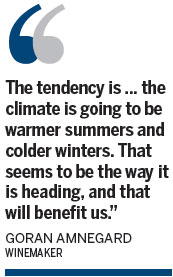Wine acquires Scandinavian bouquet
On one of the world's northernmost frontiers, grapevines are growing on hillsides, and talk among some farmers is about climate and aroma as global warming and new technology push the boundaries of wine growing.
"Maybe a touch of raspberry?" opined Wenche Hvattum, one of two farmers at the Lerkekasa vineyard west of Oslo, Norway - on the same latitude as Siberia and Alaska - debating aromas in the ruby-red juice from their freshly pressed grapes.
"This is good. I'd say a hint of black currant," said her husband, Joar Saettem.
Such talk would have been unthinkable just a few years ago, but warmer temperatures and new, cold-resistant vines are helping push wine production into Nordic countries in a rare positive spinoff from climate change.
In Blaxsta winery near Stockholm, Sweden - a farm farther north than Moscow - Goran Amnegard has won international awards for his ice wine based on the Vidal grape. He sells about 3,000 bottles a year to customers as far afield as Hong Kong, and proudly shows off his red merlot wine and white chardonnay.
"There is this myth about the cold weather here, the moose and the polar bears," said Amnegard. "We have had more or less Mediterranean summers."
Blaxsta won a gold at the World Wine Cup in 2012 for its 2009 Vidal Ice Wine. Financial Times wine critic Jancis Robinson gave it a "distinguished" 16.5 points out of a maximum 20.
"The tendency is ... the climate is going to be warmer summers and colder winters. That seems to be the way it is heading, and that will benefit us," Amnegard said.
The 1,000 vines at the Lerkekasa vineyard lie in neat rows on a south-facing hillside at Gvarv in Telemark, southern Norway.

"We want to demonstrate ... that we believe the climate is getting warmer and it is more possible to grow and make wine in northerly areas," Saettem said.
High risk
Still, Nordic vineyards make a high-risk investment because many summers are still soggy.
"They are certainly slowly improving though, being at the limit of viticulture, are more prone to disaster than vineyards closer to the equator," the FT's Robinson wrote in an e-mail, adding that seagulls had destroyed one Norwegian vineyard's crop.
"I'm sure we will continue to see more Scandinavian wines," Robinson wrote. "Though I would be very surprised to encounter naturally ripened Scandinavian cabernet sauvignon in my lifetime."
Tasting the first pressing of the year one autumn day after one of the warmest summers on record in southern Norway, Hvattum said 2014 seemed a good but not outstanding year.
"We struggled with frost and damage we had last year," she said, when temperatures plunged in winter to almost -30C. "We hope next year will be tremendous."
Producing since 2007, they expect to make 50 to 60 bottles this season.
Crops grow better in the Nordic region than at similar latitudes elsewhere because the sea is warmed by the Gulf Stream current. A comparable latitude in the Southern Hemisphere would be far south of New Zealand, near Antarctica.
A generation ago, the northernmost frontier for vineyards was Britain. Nowadays, the title of the world's most northerly vineyard is a moving target.
Several wine experts list Lerkekasa as the world's most northerly commercial outdoor vineyard, since visitors can spend the night at the farm and sample the wines.
Some other producers in Finland, Sweden and Norway have vines slightly farther north, but do not take guests, or have vines in greenhouses to shield them from the cold.
One producer farther north than Lerkekasa, Bjorn Bergum, grows his grapes by the sea in Sogndal, western Norway, under labels called "Fjord Red" and "Fjord White" marked 61.2 degrees north, the latitude of his vineyard.
(China Daily 11/26/2014 page10)














